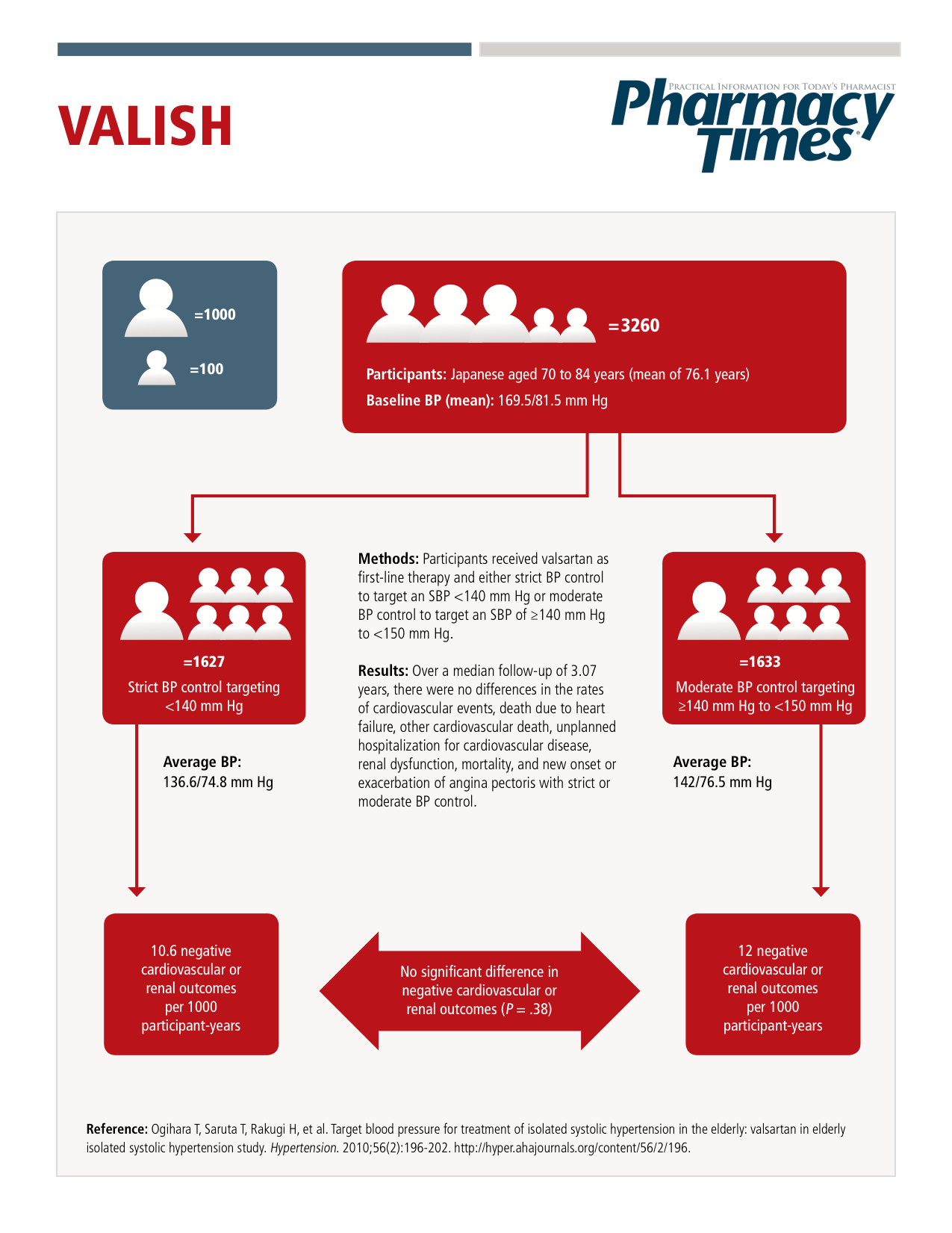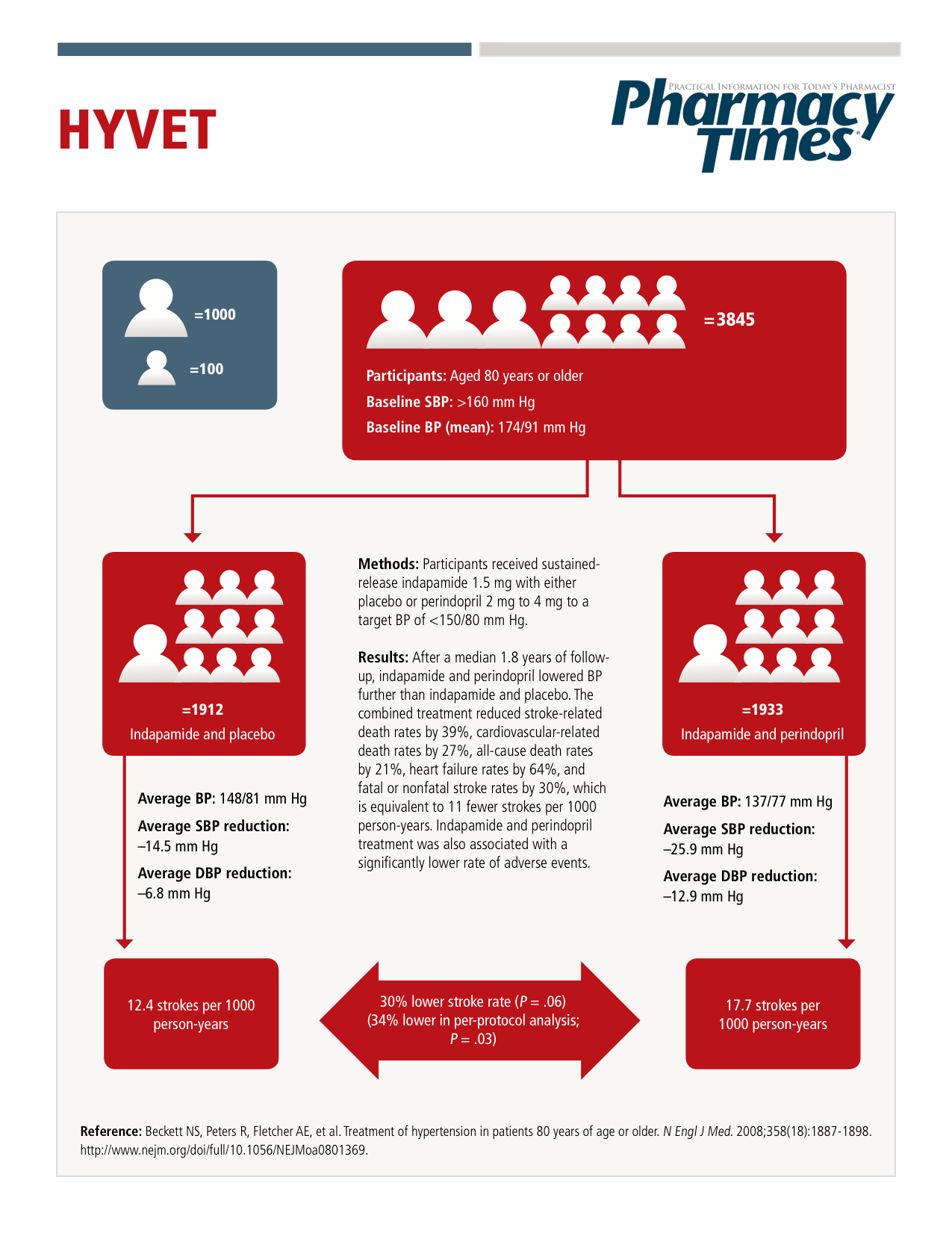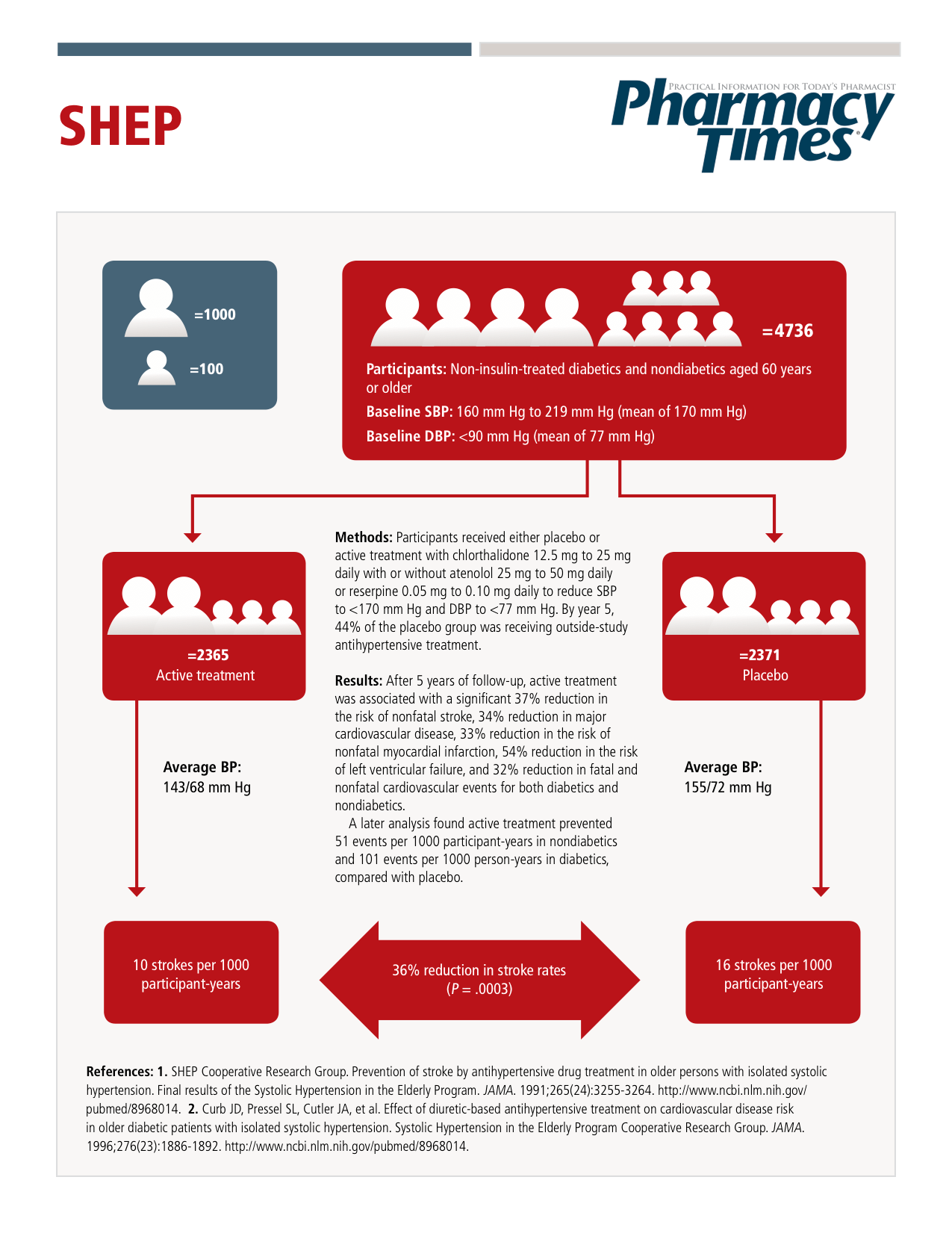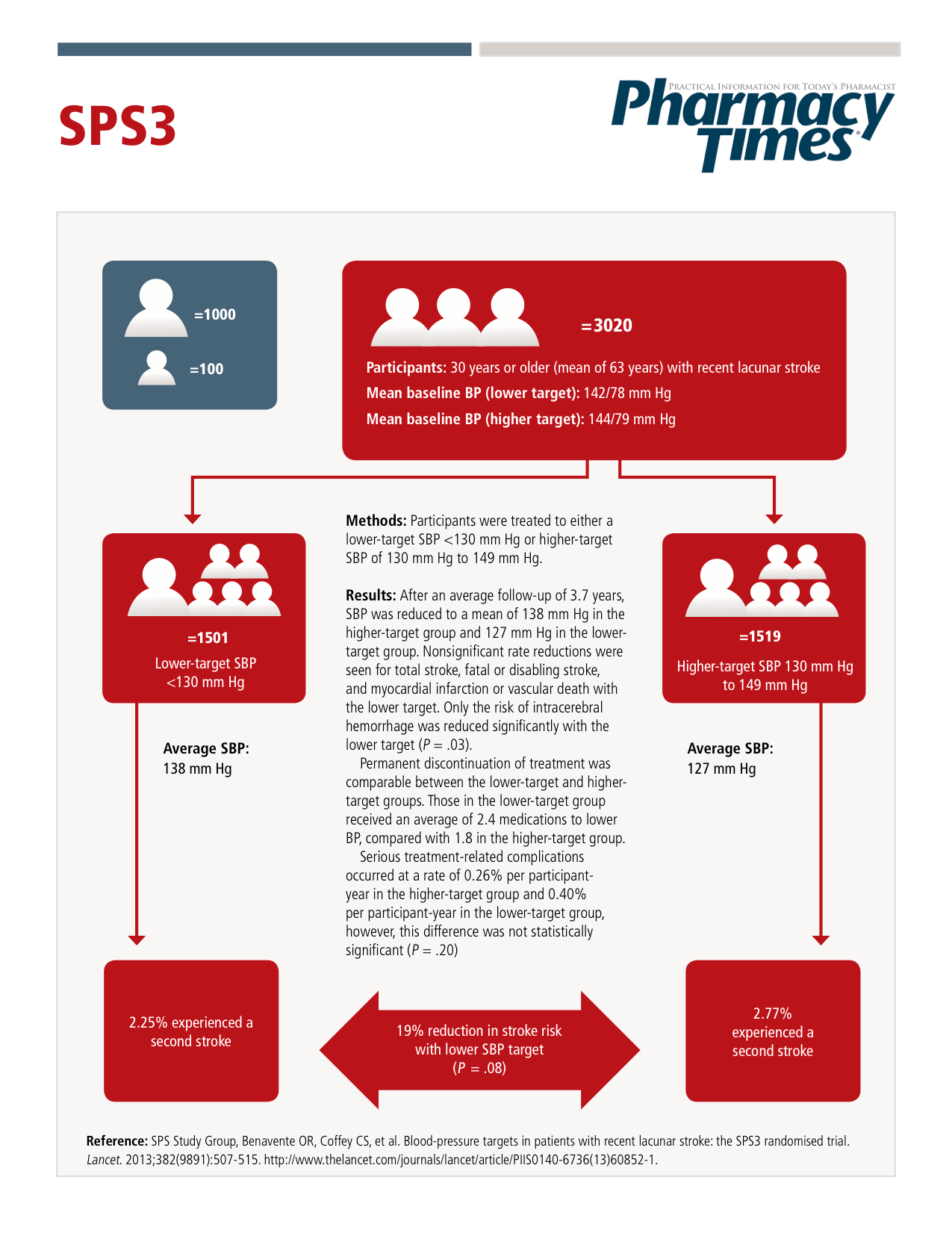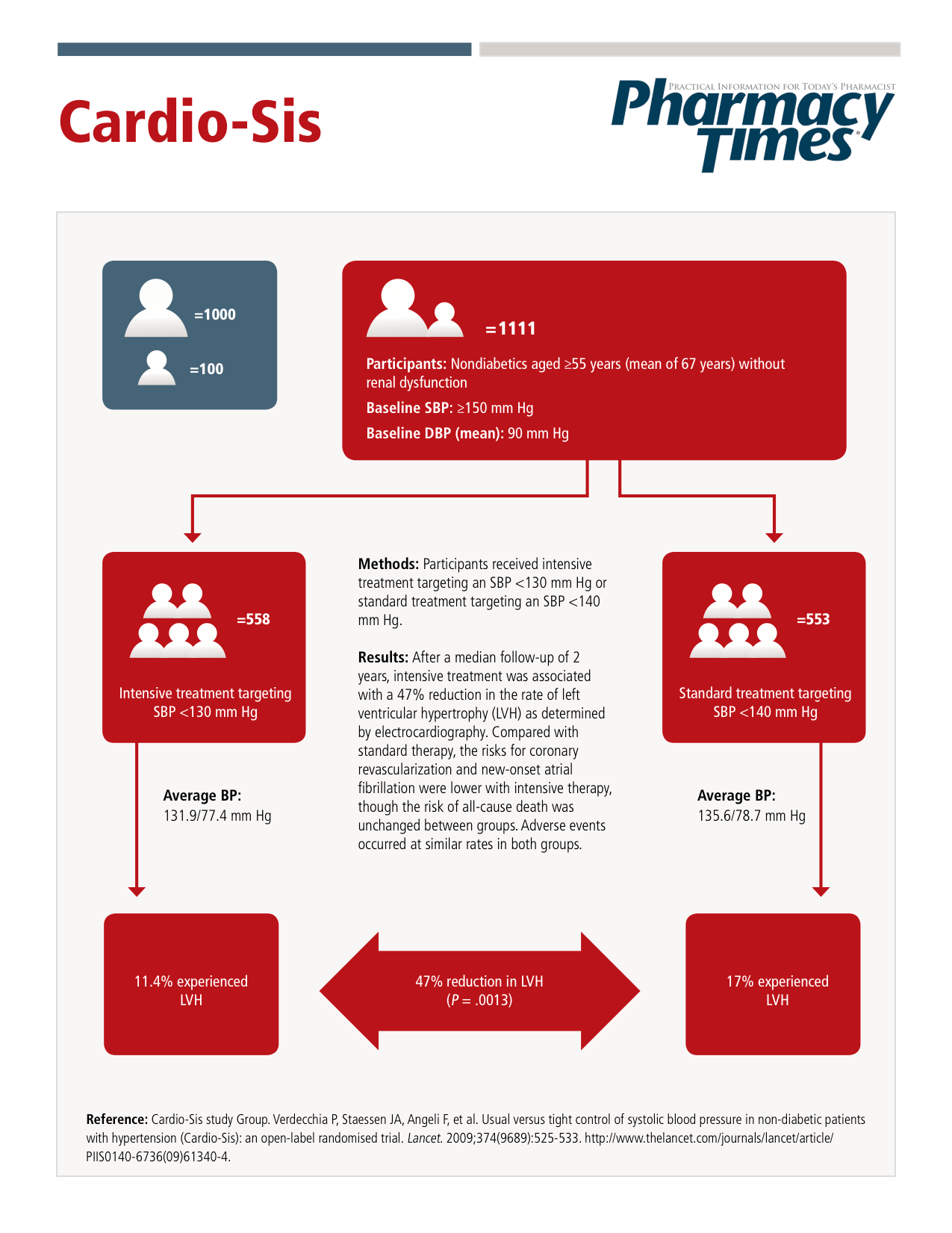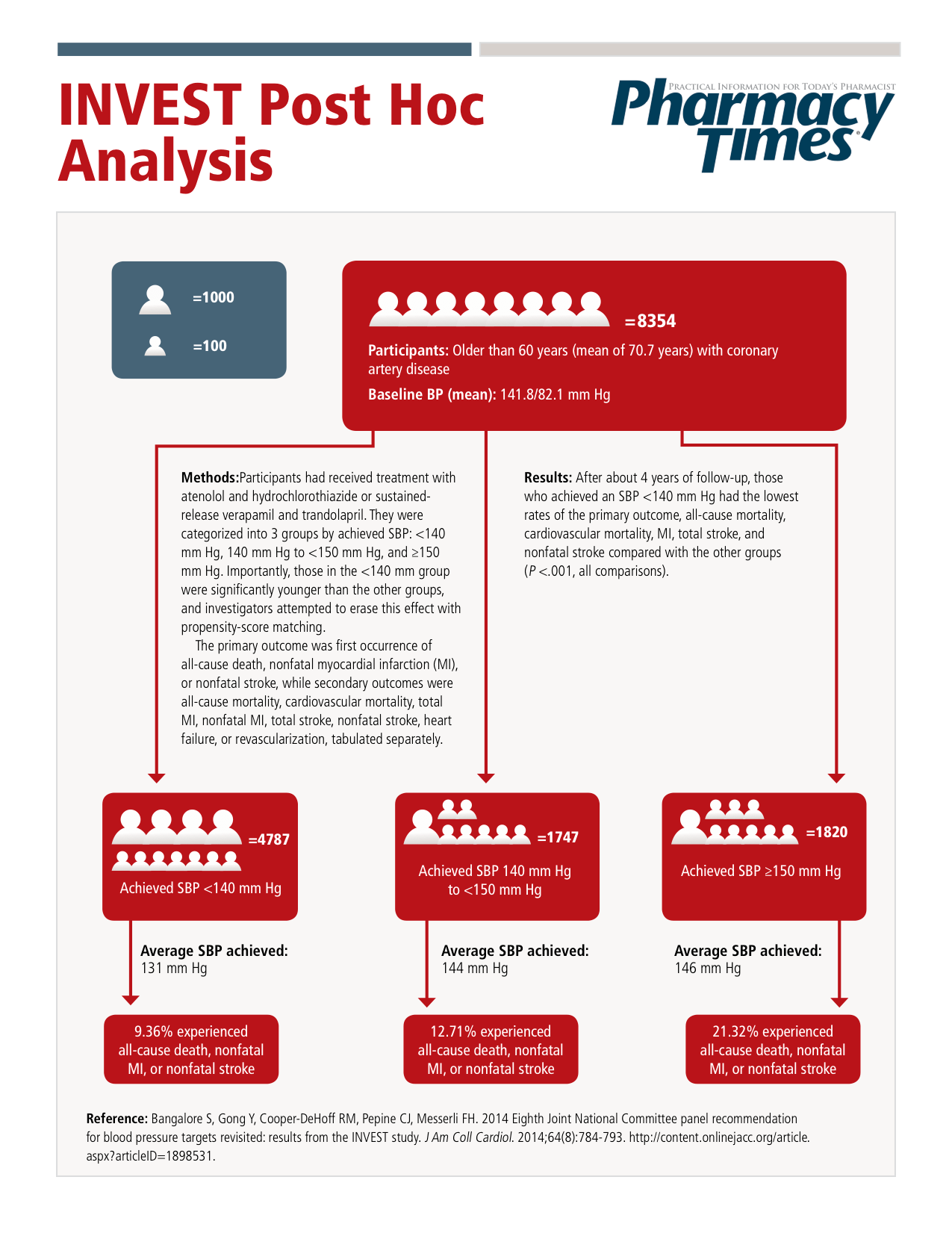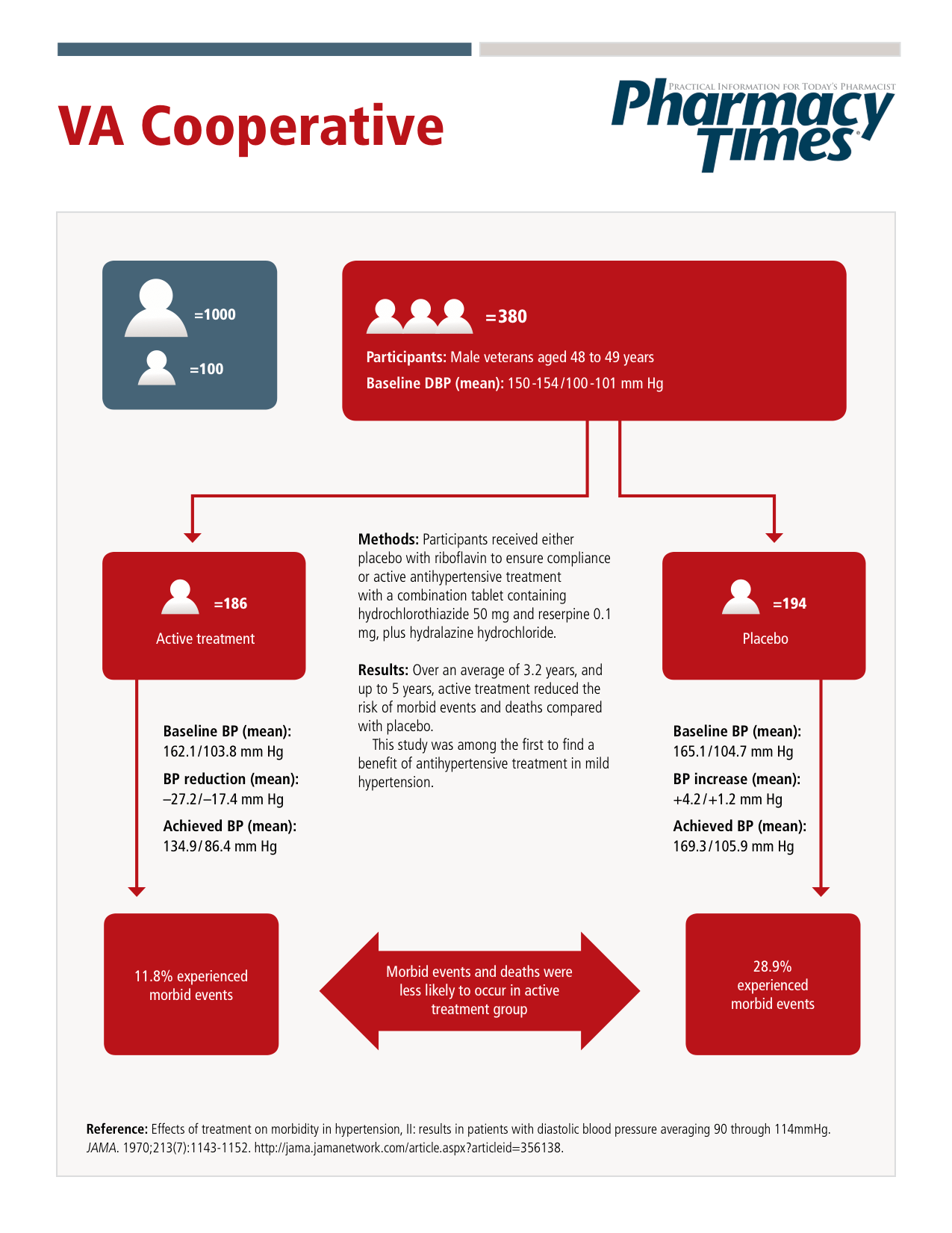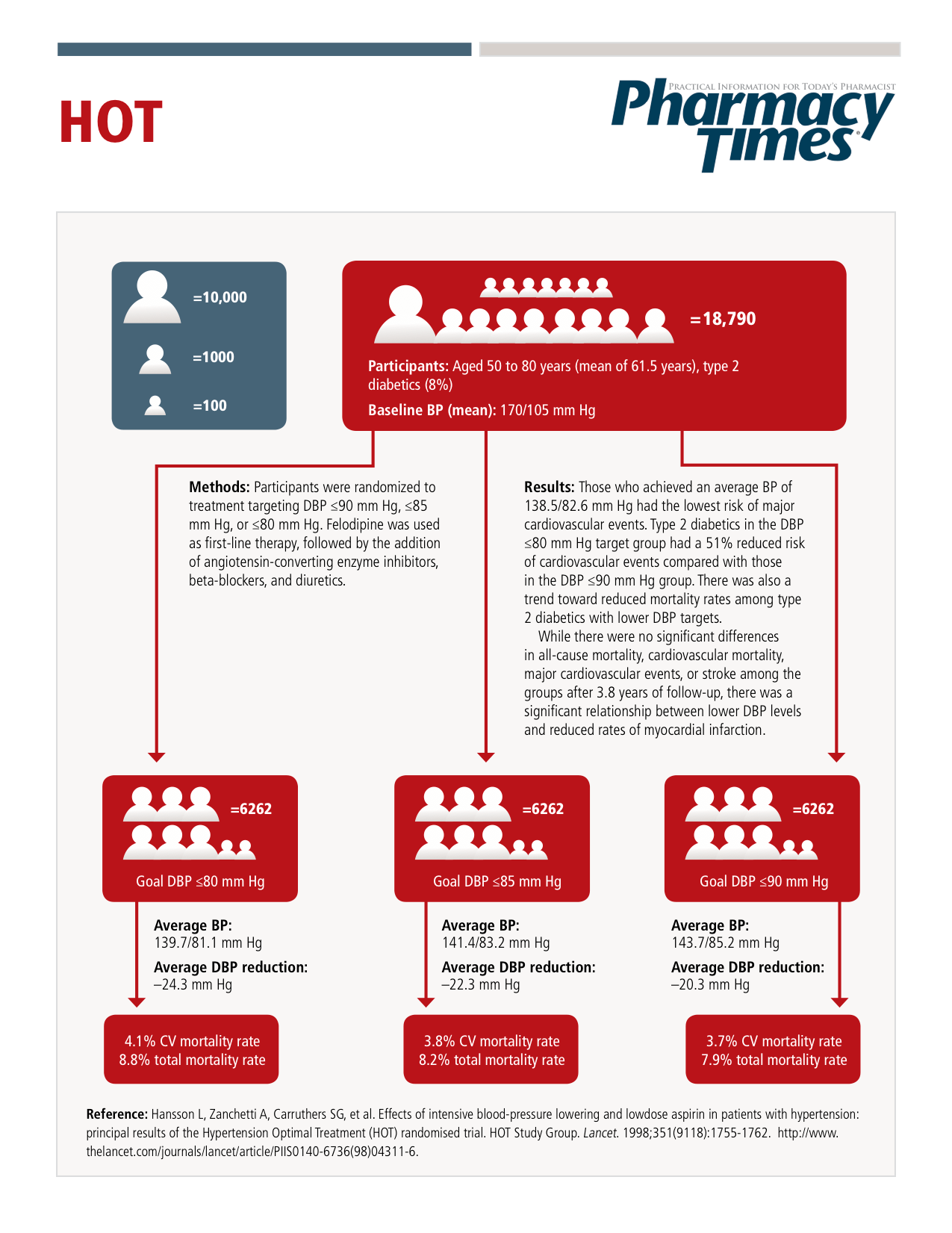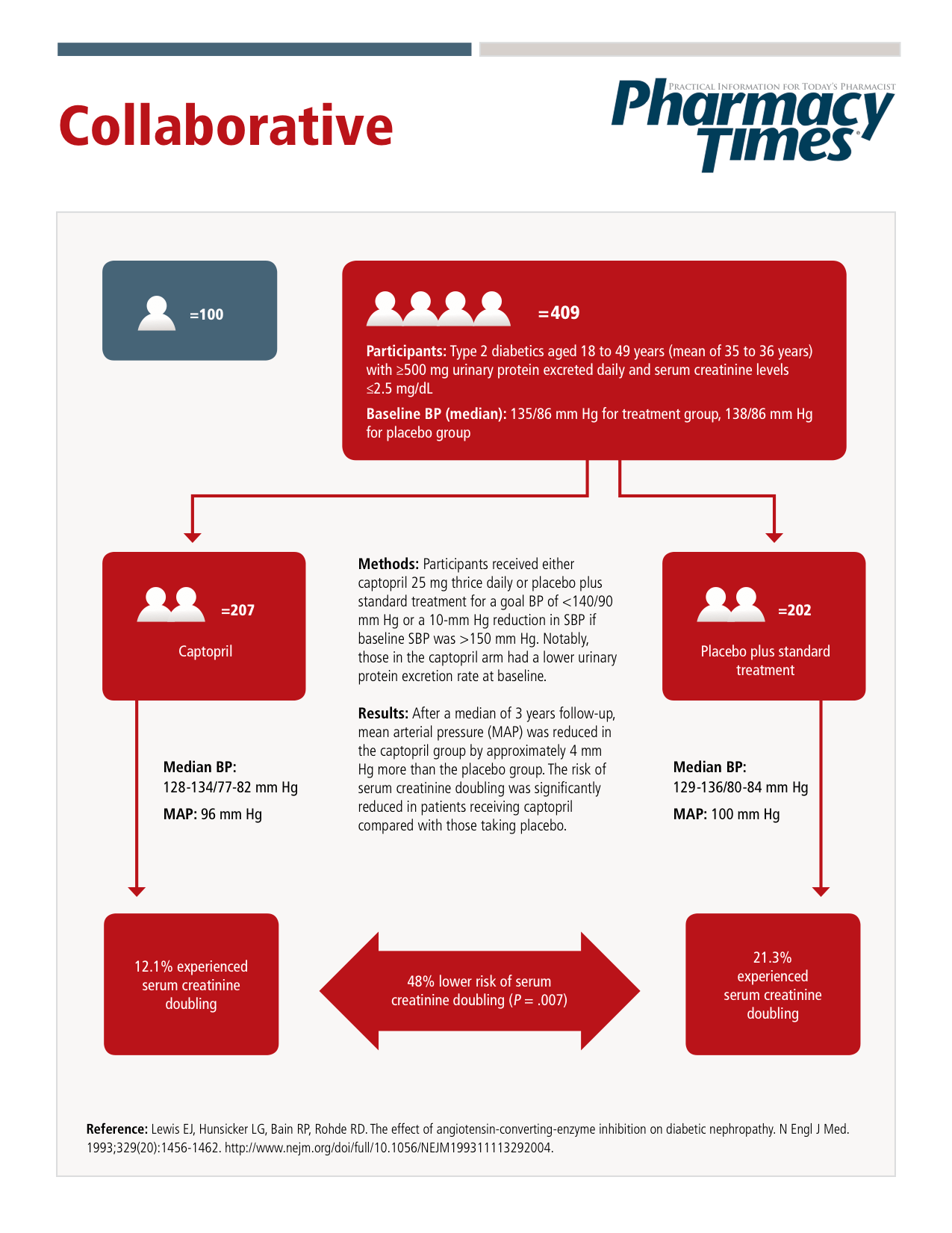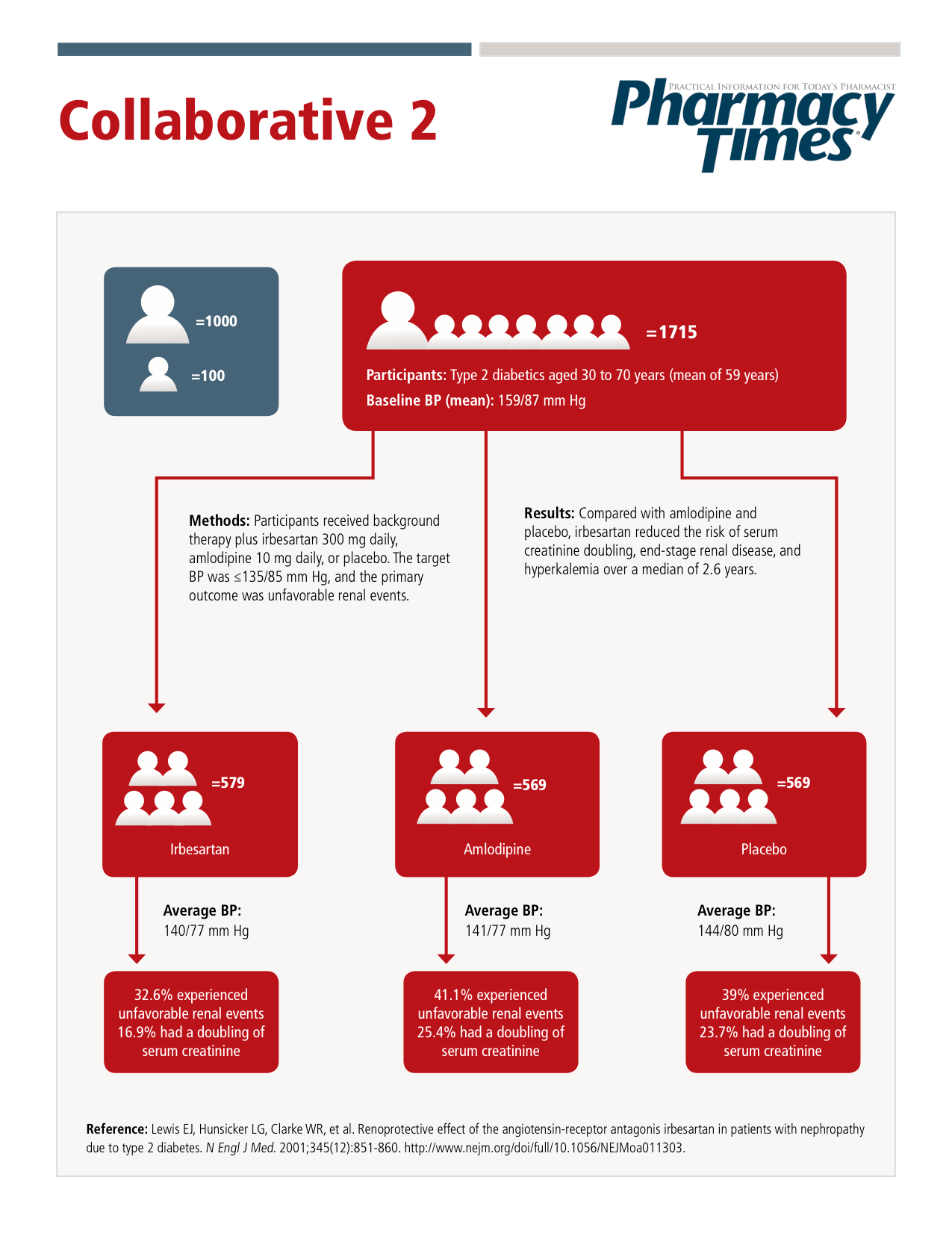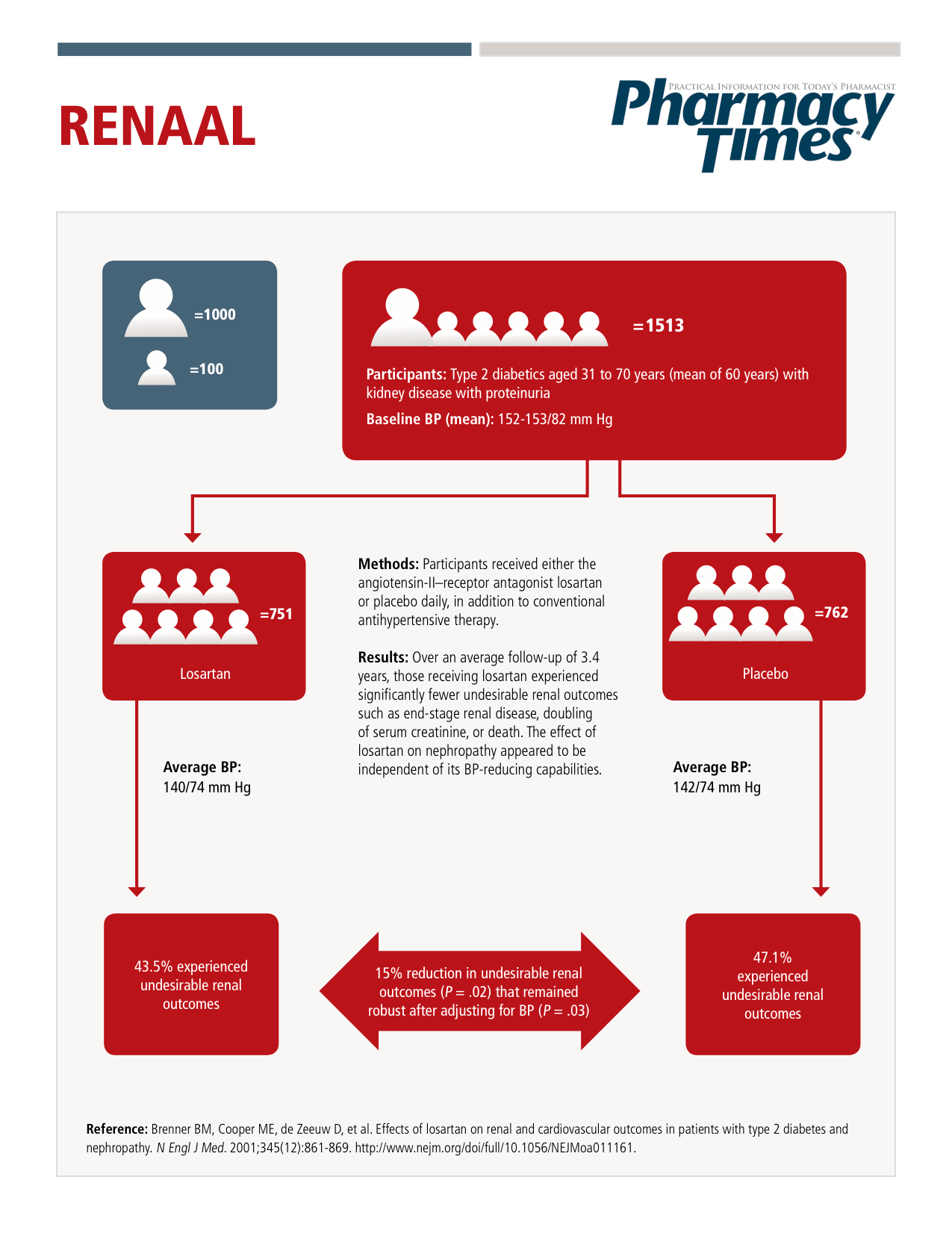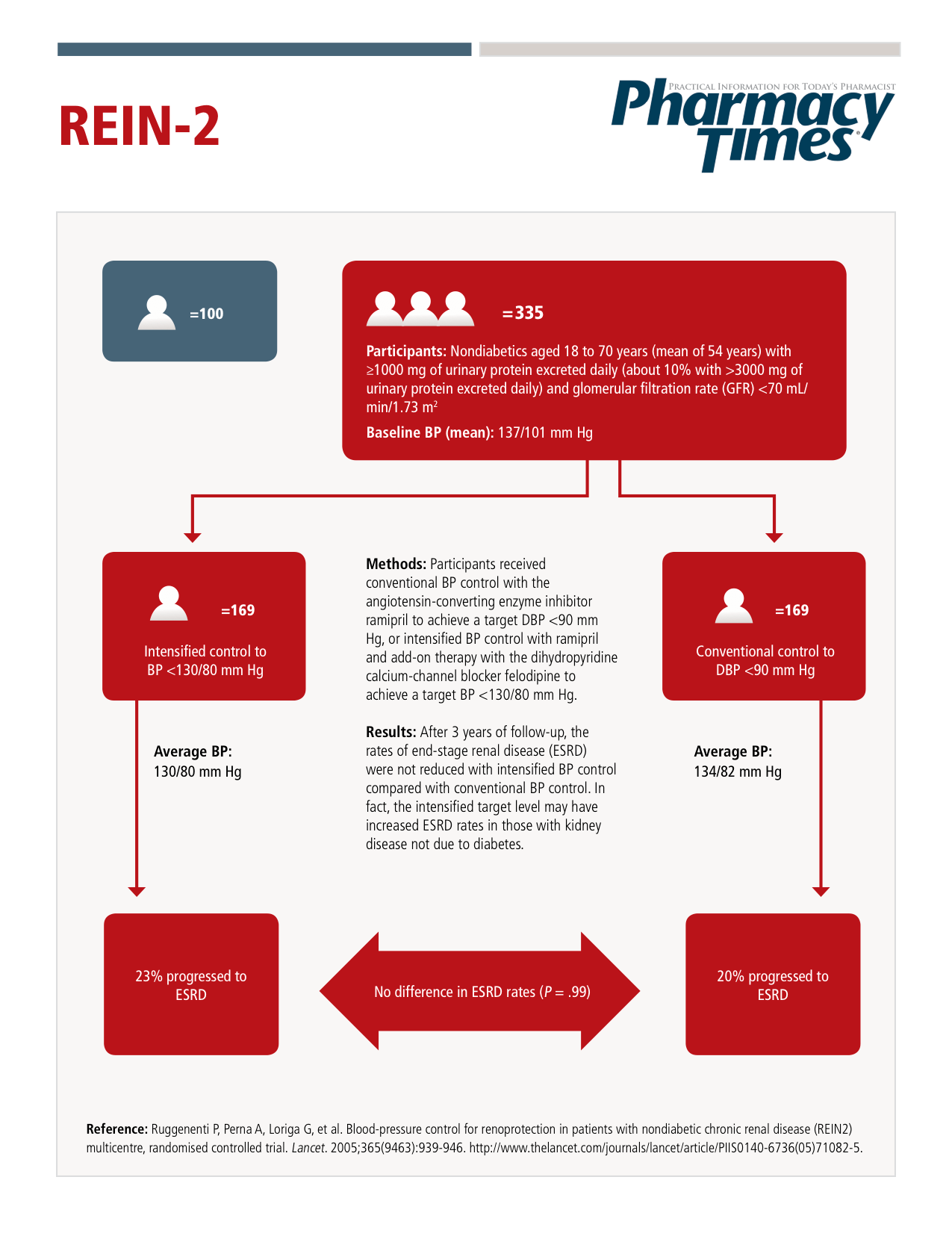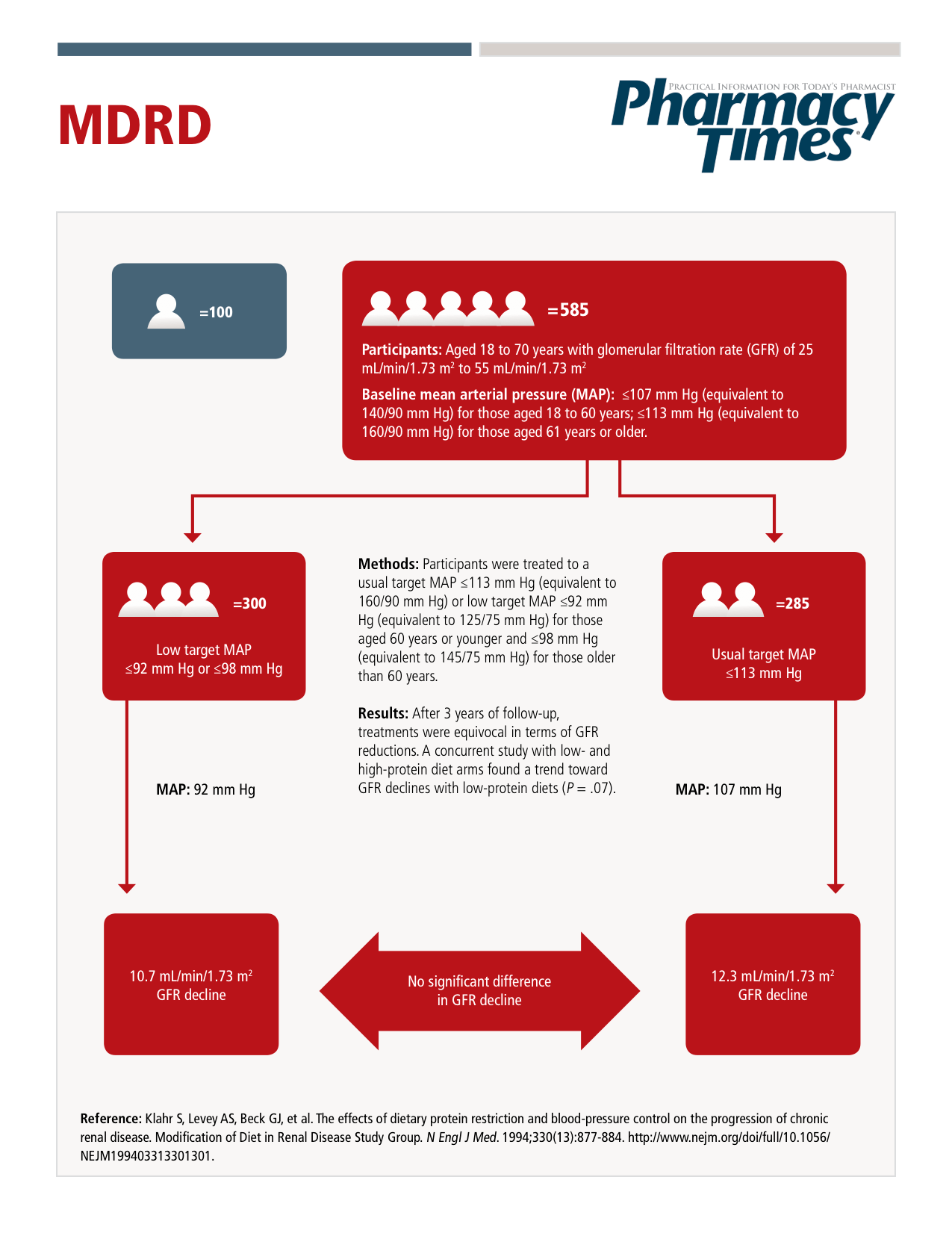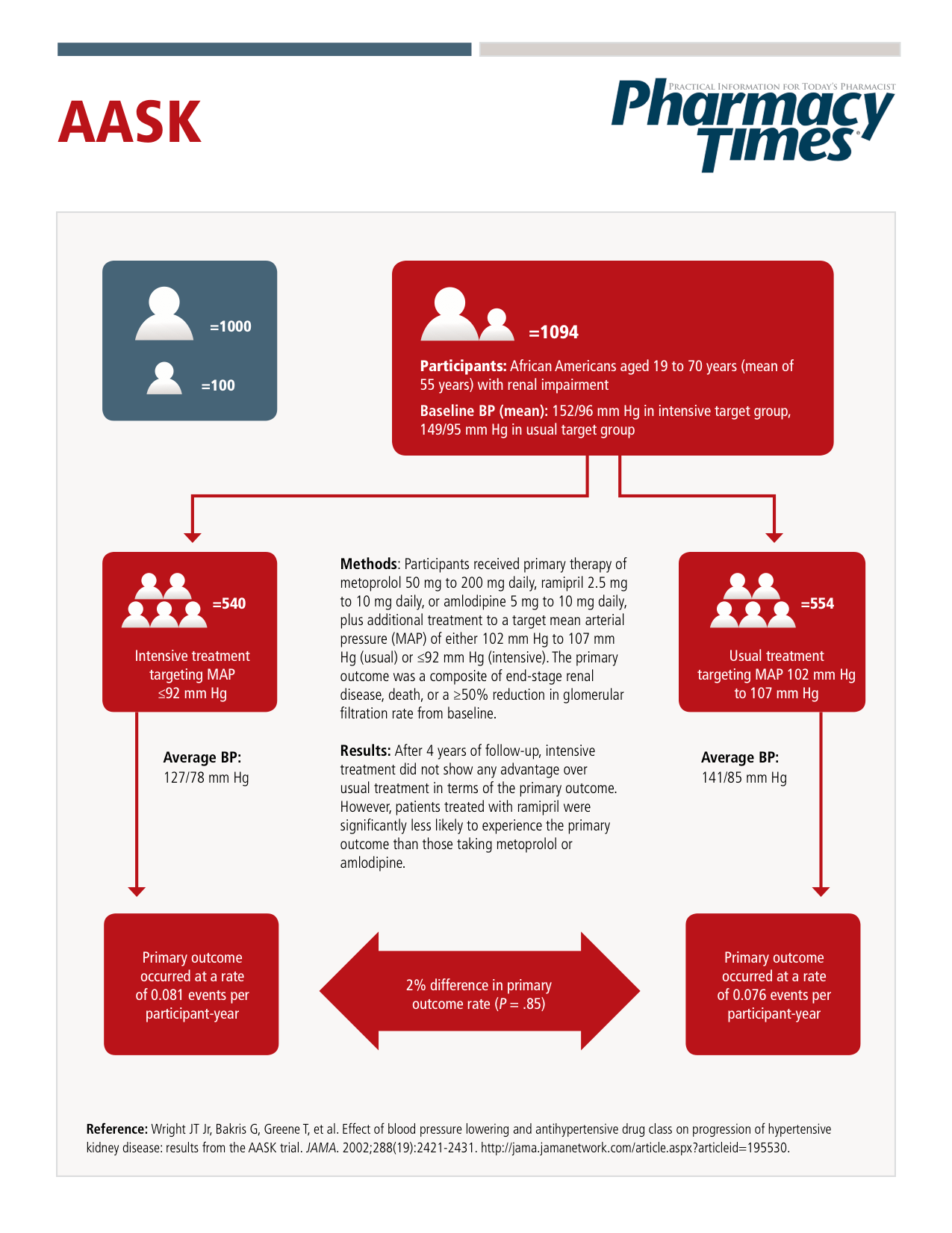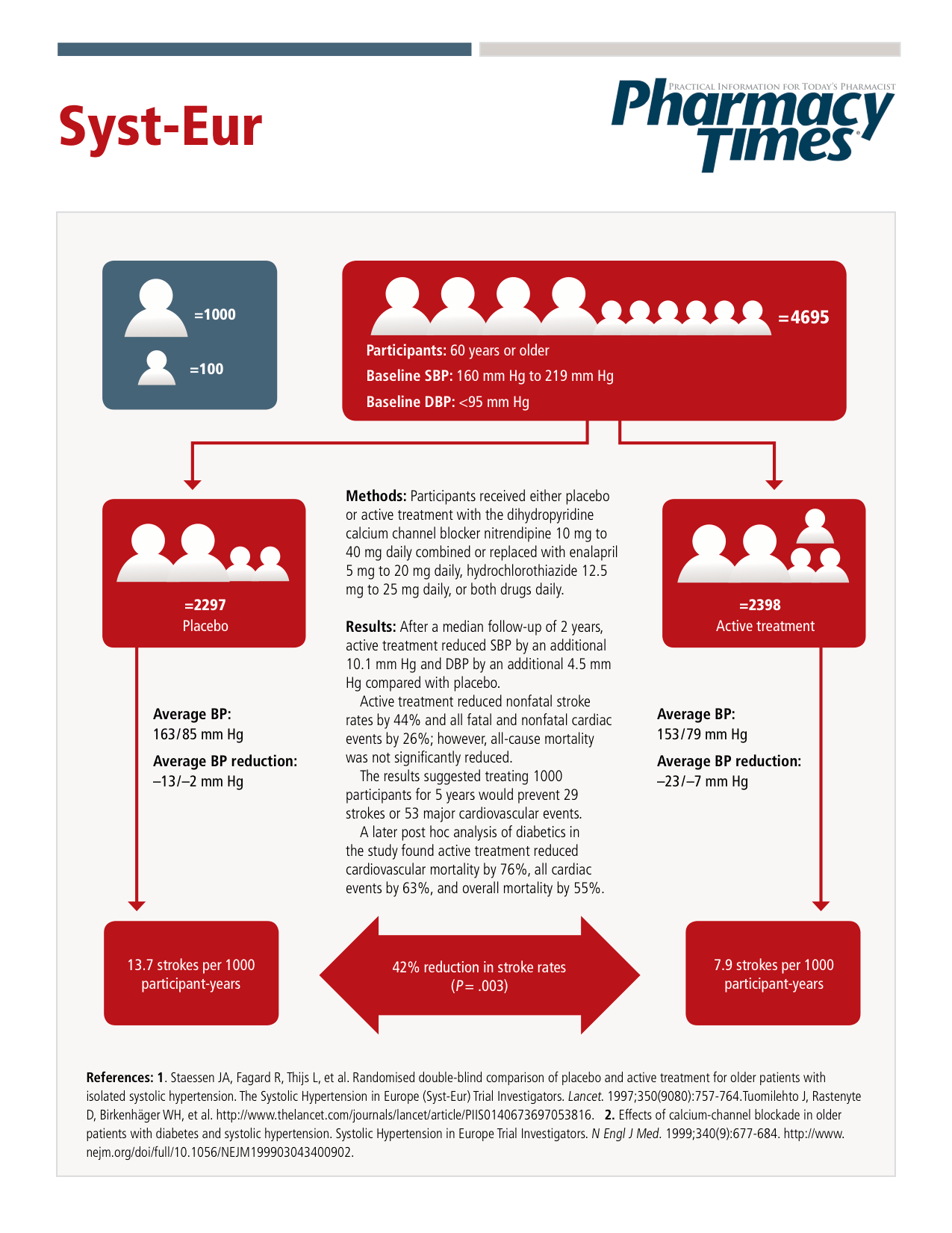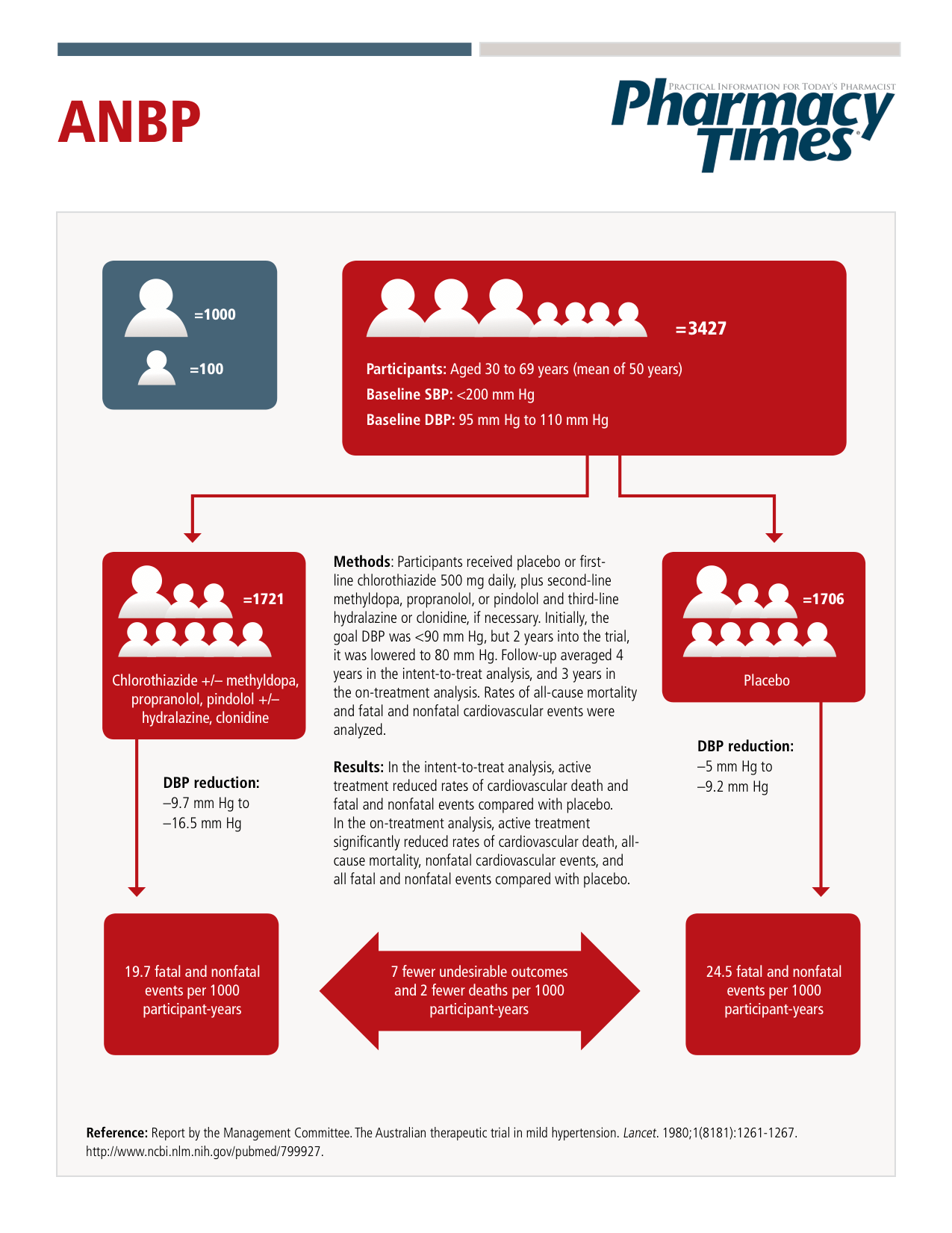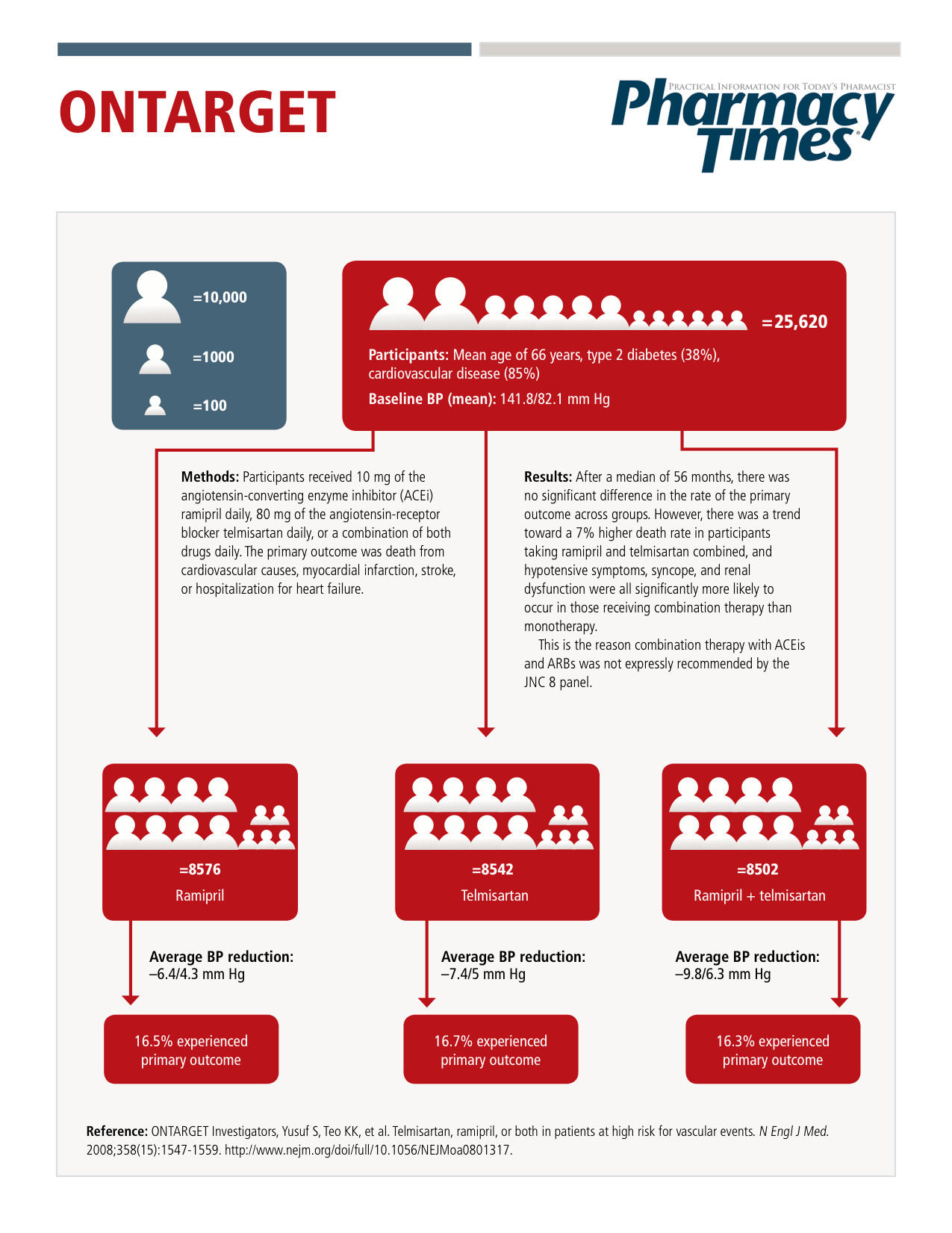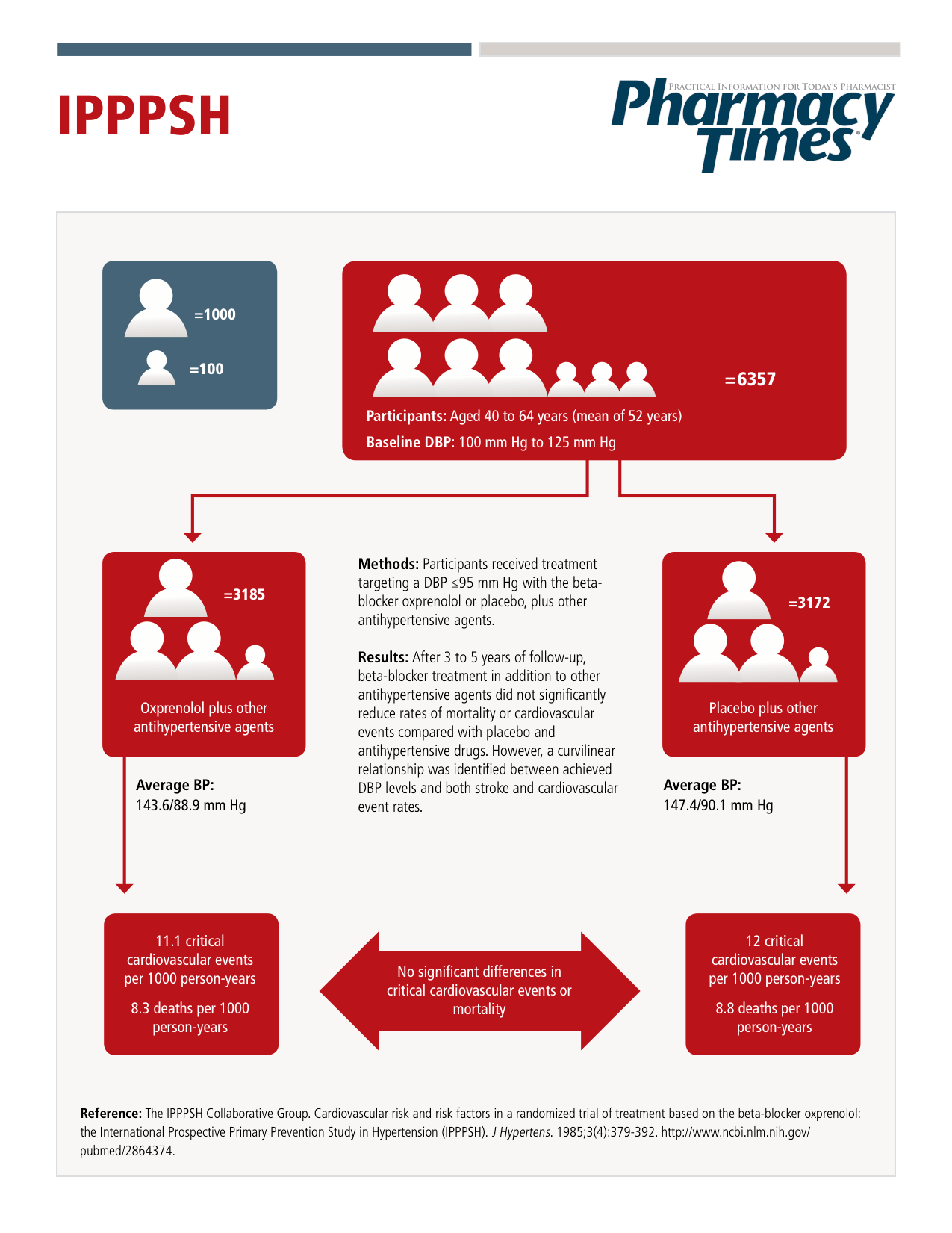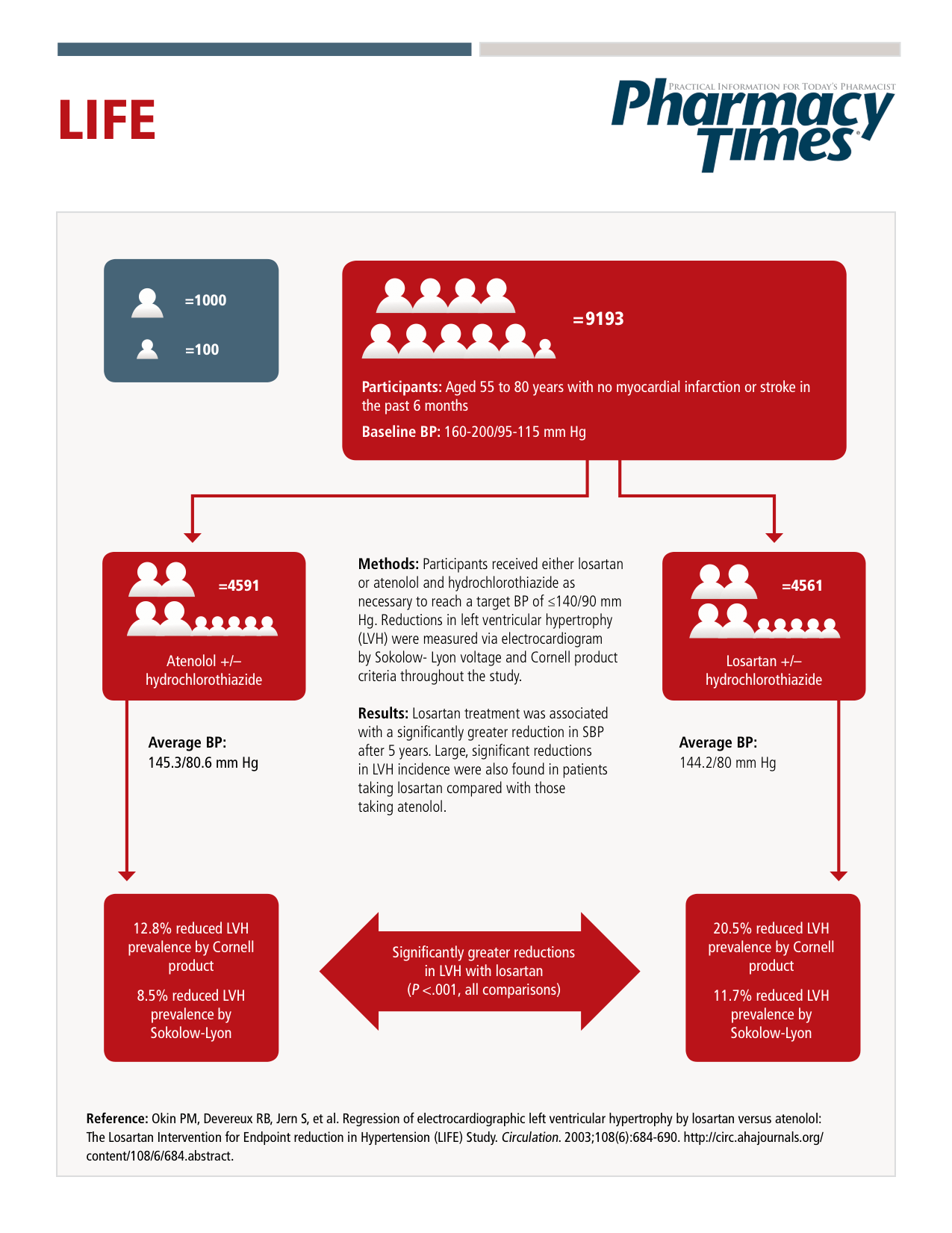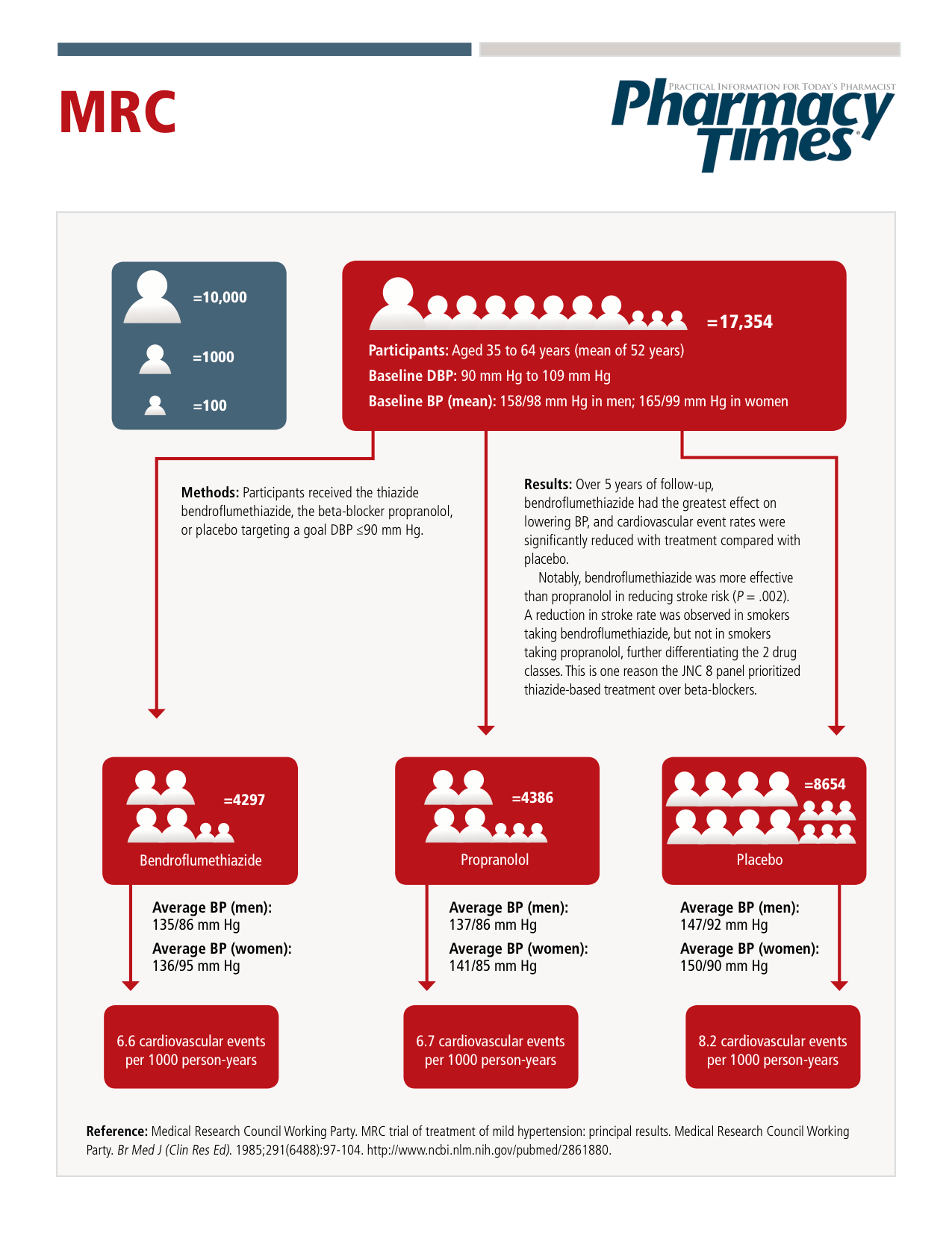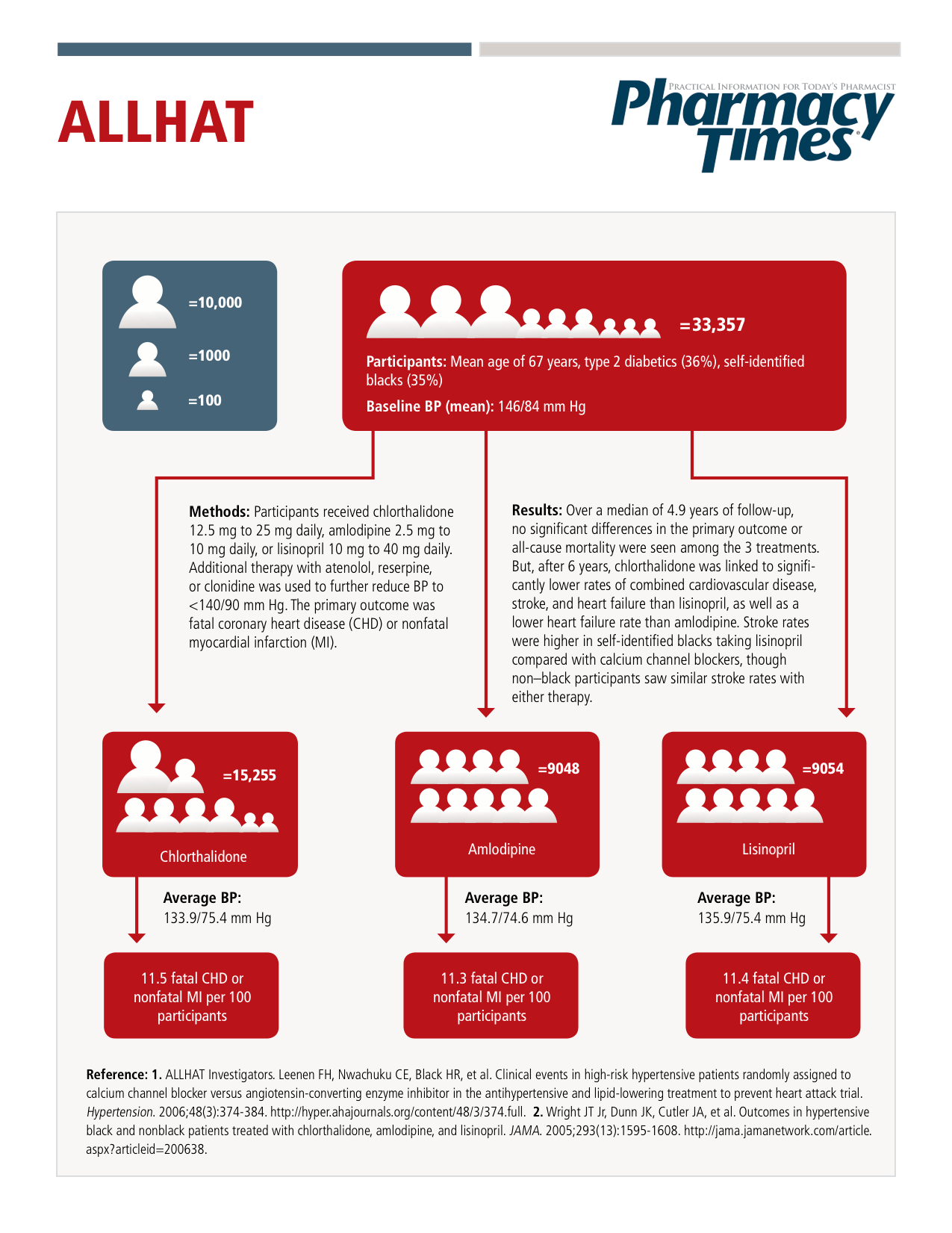JNC 8: The Clinical Core of the Hypertension Guidelines
The JNC 8 guidelines are based on 27 large clinical trials that are often discussed in isolation, but have never been aggregated into a single source until now.
The latest Joint National Committee guidelines (JNC 8) are based on 27 large clinical trials concerning hypertension management. These trials are often discussed in isolation, but their data have never been aggregated into a single source.
Now, Pharmacy Times is providing the rationale behind the JNC 8 recommendations in the context of these clinical trials.
Click the images to download easy-to-navigate infographics of each trial.
Why does the JNC 8 recommend a more relaxed blood pressure (BP) goal for patients older than 60 years?
Many health care professionals are baffled by the JNC 8 recommendation to relax BP goals in older patients, but the reasoning behind it was derived from several clinical trials, including:
- JATOS: In patients aged 65 to 85 years, intensive treatment to a goal systolic blood pressure (SBP) <140 mm Hg (BP 136/75 mm Hg) produced no better cardiovascular outcomes than treatment to a goal SBP ≥140 mm Hg and <150 mm Hg (BP 146/78 mm Hg).
- VALISH: In patients aged 70 to 84 years, intensive treatment to a goal SBP <140 mm Hg (BP 137/75 mm Hg) produced no better cardiovascular outcomes than treatment to a goal SBP ≥140 mm Hg and <150 mm Hg (BP 142/77 mm Hg).
- HYVET: In patients aged 80 years or older, treatment to a goal SBP <150/80 mm Hg with a thiazide plus an angiotensin-converting enzyme inhibitor (ACEI) led to improved outcomes over a thiazide alone. The 137/77 mm Hg average BP level achieved in the combined treatment group resulted in lower stroke rates than the 148/81 mm Hg average BP level achieved in the thiazide group.
- SHEP: In patients aged 60 years or older with diabetes, thiazide-based treatment to 143/68 mm Hg resulted in lower stroke rates than treatment to 155/72 mm Hg.
- SPS3: In patients aged 63 years on average with a previous lacunar stroke, an intensive SBP target of <130 mm Hg and achieved average SBP of 127 mm Hg produced no significant reduction in the risk of experiencing another stroke compared with an SBP target between 130 mm Hg and 149 mm Hg and achieved average SBP of 138 mm Hg. However, cerebral hemorrhage rates were reduced with the lower target level.
On the contrary:
- Cardio-Sis showed treatment to a goal SBP <130 mm Hg (BP 132/77 mm Hg) produced lower rates of left ventricular hypertrophy (LVH) in nondiabetic patients aged 55 years or older than treatment to a goal SBP <140 mm Hg (BP 136/79 mm Hg).
- A post hoc analysis of INVEST determined an unfavorable cardiovascular outcome was less likely to occur in patients older than 60 years who achieved an SBP <140 mm Hg than those who achieved an SBP <150 mm Hg, as well as those who achieved an SBP ≥150 mm Hg. Importantly, patients in the <140 mm Hg group were significantly younger and had fewer comorbidities than those in the other 2 groups. Investigators tried to compensate for this limitation with propensity-score matching, but it is important to remember that this analysis was a reaction to JNC 8 and did not have the same level of evidence as prospectively defined studies.
Commentary
Examining JATOS and VALISH, it is clear older patients perform no better on cardiovascular outcomes when treated to an SBP <150 mm Hg compared with 140 mm Hg. However, the average BP achieved in JATOS and VALISH, as well as in HYVET and SHEP, was consistently around an SBP of 140 mm Hg. This suggests that, even though the goal SBP may have been <150 mm Hg, the actual level attained in these trials was approximately 140 mm Hg. Despite this, targeting 150 mm Hg among older patients still generally results in desirable outcomes.
While the findings of the post hoc INVEST analysis are important, they are not inconsistent with those of HYVET and SHEP, because the average SBP achieved in those trials was actually around 140 mm Hg. Instead of using target levels, the analysis only refers to achieved levels, which are often lower than targets. In other words, a target SBP level <150 mm Hg is appropriate for older patients because the level achieved in trials is typically around 140 mm Hg.
Because of this, using retrospective data to set targets is a slippery slope. For instance, if the SBP target is lowered to 130 mm Hg based on a post hoc study, health care professionals may lower the level to 120 mm Hg, which may be harmful in some populations. This occurred in the ACCORD study, in which the achieved BP of 119/64 mm Hg with a goal SBP <130 mm Hg led to a reduction in stroke risk, but also resulted in a nearly 3-fold greater risk of serious adverse events.
That said, not all populations should be treated the same way. In Cardio-Sis, for instance, LVH was less likely to develop in patients treated to an SBP <130 mm Hg than those treated to <140 mm Hg, suggesting that lower SBP targets may have additional benefits in patients at risk for heart failure (HF).
Why does the JNC 8 recommend BP reduction therapy starting at a diastolic blood pressure (DBP) >90 mm Hg and treating to <90 mm Hg in patients younger than 60 years?
The JNC 8 panel officially stated that this recommendation was based on expert opinion, but several studies it cited provide rationale for this practice. For instance:
- In VA Cooperative, one of the earliest trials in hypertension, relatively young patients (median age of 48 to 49 years) who achieved DBP <90 mm Hg were less likely to experience morbid events.
- In MRC, patients were treated to a goal DBP ≤90 mm Hg.
- The IPPPSH trial identified a continuous curve correlating stroke rates and cardiovascular event rates with achieved DBP levels. Stroke rates and cardiovascular event rates leveled off at a DBP ≤90 mm Hg.
- The HDFP trial found that targeting a DBP <90 mm Hg was superior to standard care in terms of reducing mortality rates.
- Perhaps most compelling is the HOT trial, which found a trend toward increasingly high rates of cardiovascular mortality and stroke-related mortality as diastolic targets moved downward from a goal DBP of ≤90 mm Hg, to ≤85 mm Hg, to ≤80 mm Hg.
Commentary
It seems logical that the lower the BP, the better the outcomes. However, the opposite effect was identified in the HOT trial, in which the lowest rate of cardiovascular events occurred in patients with BP around 140/90 mm Hg, and mortality rates increased when BP was lowered excessively. This is known as the J-curve phenomenon.
Importantly, this may not be true for all populations, such as patients with diabetes or those who have experienced a previous stroke. Nevertheless, the higher target is reasonable in patients similar to the population enrolled in HOT.
Why does the JNC 8 recommend antihypertensive treatment starting at 140/90 mm Hg and treating to <140/90 mm Hg in adult patients with chronic kidney disease?
This recommendation is based on findings from the Collaborative, Collaborative 2, REIN-2, MDRD, RENAAL, and AASK trials:
- Collaborative, Collaborative 2, and RENAAL showed benefits of ACEIs and angiotensin II receptor blockers (ARBs) in slowing nephropathy in patients with diabetes and kidney damage.
- REIN-2, MDRD, and AASK determined intensive BP reduction provides no additional benefit, and may actually harm patients with kidney damage. What seems to be more important than BP targets is the agent used. For example, ACEIs and ARBs may be better than calcium channel blockers (CCBs).
- Previously, the benefits of ACEIs in patients of African descent were called into question by a subgroup analysis of ALLHAT that showed a roughly 40% greater risk of stroke in such patients with diabetes treated with ACEIs, rather than CCBs. An important finding of AASK was patients of African descent who have diabetes-related kidney disease with proteinuria benefit from ACEI therapy in terms of renal outcomes.
Commentary
Lower BP targets do not seem to aid patients with chronic kidney disease, but the use of ACEIs and ARBs over CCBs does help slow the decline in renal function. AASK is important because it shows the value of ACEIs in patients of African descent, which was previously called into question by a subgroup analysis of ALLHAT.
Why does JNC 8 recommend antihypertensive treatment starting at a BP of 140/90 mm Hg and treating to <140/90 mm Hg in adult patients with diabetes?
This recommendation was based on results from SHEP, Syst-Eur, UKPDS, and ACCORD:
- In SHEP, patients aged 60 years or older who achieved an average BP of 143/68 mm Hg had lower stroke rates than those who achieved an average BP of 155/72 mm Hg. The cardiovascular event rate reduction was 51 per 1000 person-years in all patients, and 101 per 1000 person-years in patients with type 2 diabetes.
- In Syst-Eur, patients aged 60 years or older who achieved an average BP of 153/79 mm Hg had lower stroke rates than those who achieved an average BP of 163/85 mm Hg. A subgroup analysis of patients with type 2 diabetes identified a 76% reduction in cardiovascular mortality, a 63% reduction in cardiac events, and a 55% reduction in overall mortality (26.1 deaths per 1000 person-years in the more intensive treatment group and 45.1 deaths per 1000 person-years in the less intensive treatment group).
- In UKPDS, diabetic patients with an average age of 56 years who achieved an average BP of 144/82 mm Hg had lower stroke rates than those who achieved an average BP of 154/87 mm Hg.
- ACCORD showed that diabetic patients aged 62 years on average who achieved a mean BP of 119/64 mm Hg had lower stroke rates than those who achieved a mean BP of 133/71 mm Hg. However, this intensive lowering increased the risk of serious adverse events almost 3-fold.
Commentary
Looking at the BP levels achieved in the major trials, a goal SBP around 140 mm Hg seems reasonable, given that the average levels attained are often substantially lower than the targets used. In SHEP, for instance, the target SBP was <160 mm Hg, but the attained level was around 140 mm Hg. Looking at the evidence as a whole, 140 mm Hg is a sensible evidence-based target for adults with diabetes.
Why does JNC 8 recommend combinations of thiazides, CCBs, and ACEIs or ARBs (but not both together) as the mainline strategy for BP reduction?
Thiazide-type diuretics still have the best evidence of efficacy in patients with hypertension. In fact, thiazides were the basis of therapy in HYVET (indapamide), ANBP (chlorothiazide), MRC (bendrofluazide), SHEP (chlorthalidone), VA Cooperative (hydrochlorothiazide), Hypertension-Stroke Cooperative (methyclothiazide), ADVANCE (indapamide), and an arm of ALLHAT (chlorthalidone).
Of these, ALLHAT offers the clearest evidence in favor of thiazides, as it showed chlorthalidone-based therapy leads to lower rates of cardiovascular disease, stroke, and HF than lisinopril-based therapy, as well as lower HF rates than amlodipine-based therapy.
Combining ACEIs and ARBs is not recommended, due to the findings of one of the largest-ever trials in hypertension, ONTARGET.
In ONTARGET, patients were randomized to receive ramipril 10 mg, telmisartan 80 mg, or both drugs combined. In the end, there was no cardiovascular benefit from combining the ACEI and ARB, but the incidence of renal dysfunction was about 10% in each of the monotherapy groups and >13% in the combination therapy group (amounting to a significant 33% higher risk of adverse renal events.)
Some trials in HF patients have trended toward a benefit in combining ACEIs and ARBs, but the evidence is inconsistent. The theory is that blocking more points on the renin-angiotensin-aldosterone system (RAAS) will result in less remodeling of the heart, but clinicians should be aware that blocking the RAAS too aggressively can cause irreparable harm to the kidneys.
Even though beta-blockers are important components of HF treatment, they have fallen out of favor with the JNC 8. The guidelines do not provide comorbidity-specific advice on antihypertensive treatment for HF patients, but a general rule to follow for appropriate therapies is “ABCD”: ACEIs/ARBs, beta-blockers, CCBs, diuretics (and sometimes digoxin). Spironolactone and eplerenone may also be helpful in patients with very low ejection fractions, based on the RALES and EPHESUS trials (not reviewed here).
In hypertensive patients without HF, as well as those who have not experienced a myocardial infarction, beta-blockers are generally not a good first-line option, given the results of IPPPSH, LIFE, and MRC:
- IPPPSH found no significant difference between the beta-blocker oxprenolol and placebo. Even though oxprenolol reduced BP levels to 144/89 mm Hg, compared with 147/90 mm Hg in the control group, the rate of critical cardiovascular events was unaffected after 3 to 5 years of therapy.
- LIFE found significantly lower rates of LVH in patients receiving losartan-based therapy than in those receiving atenolol-based therapy over 5 years of follow-up, with comparable BP reductions seen in each group.
- MRC determined propranolol performed worse than bendrofluazide, a thiazide-type diuretic, in preventing stroke over 5 years.
Commentary
Combinations of thiazides, CCBs, and either ACEIs or ARBs (but not both) are good mainline options for treating hypertension in patients who do not have other compelling indications for drugs like beta-blockers. Nevertheless, it is important to choose a therapy that is sensible based on each patient’s comorbidities.
Although the JNC 7 refers to some research on the relationship between heart rate and mortality rates, large prospective trials do not support using beta-blockers as first-line therapy in patients with hypertension who do not have other compelling indications for their use.
Why doesn’t the JNC 8 recommend the use of ACEIs as first-line treatment in patients of African descent, favoring thiazides and CCBs instead?
A subgroup analysis of ALLHAT found that patients of African descent had a 40% higher rate of stroke when treated with ACEIs than similar patients treated with CCBs or thiazides. It is important to remember that patients of African descent can still benefit from ACEIs if they have diabetes with proteinuria, as shown in the AASK trial. However, ACEIs in this population may be better as an add-on agent than as a first-line therapy.
Decide for Yourself
Familiarity with these large prospective trials is an important priority for pharmacists, physicians, and other health care professionals seeking a deeper understanding of hypertension management. Recognizing the characteristics of populations involved in these trials can also help health care professionals select treatments and target BP levels that lead to positive outcomes in specific patient groups. Familiarity with these trials also explains some of the controversy, as well as the limitations of the evidence base behind JNC 8.
For instance, JNC 8 was developed almost exclusively from prospective studies, excluding data from retrospective studies and meta-analyses, both of which were important in the development of JNC 7. Incorporation of retrospective analyses of data from INVEST and other studies into guideline development led to the recent American Heart Association, American College of Cardiology, and American Society of Hypertension recommending lower SBP targets (<130 mm Hg) in some groups of patients, including those with coronary artery disease, acute coronary syndrome, stable angina, and ischemic heart failure. These guidelines should be taken into consideration for patients with these comorbidities.
However, achieved BP levels analyzed retrospectively differ greatly from target ones. Therefore, applying conclusions from retrospective data to develop goal levels can lead to confusion over the appropriate BP to target in patients. Developing guidelines based on prospective data, which are clinically applicable, and retrospective studies, which are meant to generate hypotheses, is at the root of the JNC 7 and JNC 8 controversies.
For the vast majority of patients, JNC 8 and the trials that comprise it represent a good general practice approach. In addition, JNC 8 draws attention to a subset of the most important prospective clinical trials that provide the evidence base for hypertension management. Understanding these trials and applying their results to individual patients provides more clinical value than guidelines alone can achieve.
References
1. James PA, Oparil S, Carter BL, et al. 2014 evidence-based guideline for the management of high blood pressure in adults: report from the panel members appointed to the Eighth Joint National Committee (JNC 8). JAMA. 2014;311(5):507-520.
2. Rosendorff C, Lackland DT, Allison M, et al. Treatment of hypertension in patients with coronary artery disease: A scientific statement from the American Heart Association, American College of Cardiology, and American Society of Hypertension. J Am Soc Hypertens. 2015.


